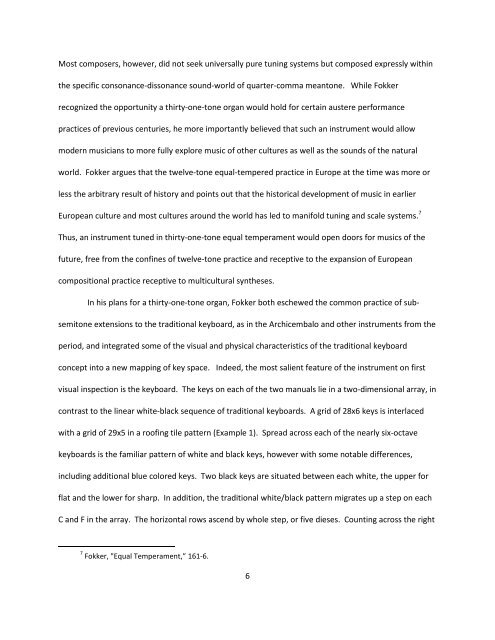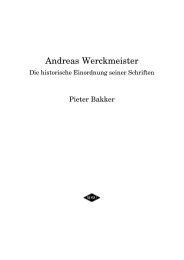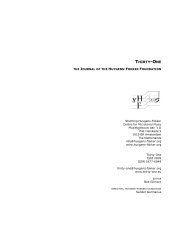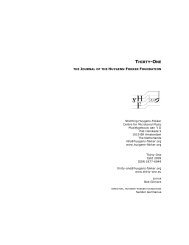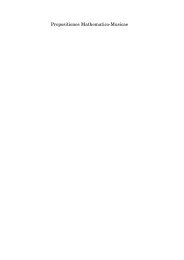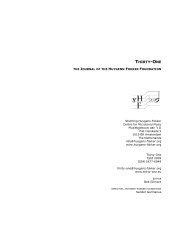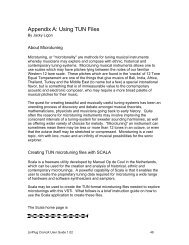Recent Organ Design Innovations and the 21st-century - Stichting ...
Recent Organ Design Innovations and the 21st-century - Stichting ...
Recent Organ Design Innovations and the 21st-century - Stichting ...
Create successful ePaper yourself
Turn your PDF publications into a flip-book with our unique Google optimized e-Paper software.
Most composers, however, did not seek universally pure tuning systems but composed expressly within<br />
<strong>the</strong> specific consonance-dissonance sound-world of quarter-comma meantone. While Fokker<br />
recognized <strong>the</strong> opportunity a thirty-one-tone organ would hold for certain austere performance<br />
practices of previous centuries, he more importantly believed that such an instrument would allow<br />
modern musicians to more fully explore music of o<strong>the</strong>r cultures as well as <strong>the</strong> sounds of <strong>the</strong> natural<br />
world. Fokker argues that <strong>the</strong> twelve-tone equal-tempered practice in Europe at <strong>the</strong> time was more or<br />
less <strong>the</strong> arbitrary result of history <strong>and</strong> points out that <strong>the</strong> historical development of music in earlier<br />
European culture <strong>and</strong> most cultures around <strong>the</strong> world has led to manifold tuning <strong>and</strong> scale systems. 7<br />
Thus, an instrument tuned in thirty-one-tone equal temperament would open doors for musics of <strong>the</strong><br />
future, free from <strong>the</strong> confines of twelve-tone practice <strong>and</strong> receptive to <strong>the</strong> expansion of European<br />
compositional practice receptive to multicultural syn<strong>the</strong>ses.<br />
In his plans for a thirty-one-tone organ, Fokker both eschewed <strong>the</strong> common practice of sub-<br />
semitone extensions to <strong>the</strong> traditional keyboard, as in <strong>the</strong> Archicembalo <strong>and</strong> o<strong>the</strong>r instruments from <strong>the</strong><br />
period, <strong>and</strong> integrated some of <strong>the</strong> visual <strong>and</strong> physical characteristics of <strong>the</strong> traditional keyboard<br />
concept into a new mapping of key space. Indeed, <strong>the</strong> most salient feature of <strong>the</strong> instrument on first<br />
visual inspection is <strong>the</strong> keyboard. The keys on each of <strong>the</strong> two manuals lie in a two-dimensional array, in<br />
contrast to <strong>the</strong> linear white-black sequence of traditional keyboards. A grid of 28x6 keys is interlaced<br />
with a grid of 29x5 in a roofing tile pattern (Example 1). Spread across each of <strong>the</strong> nearly six-octave<br />
keyboards is <strong>the</strong> familiar pattern of white <strong>and</strong> black keys, however with some notable differences,<br />
including additional blue colored keys. Two black keys are situated between each white, <strong>the</strong> upper for<br />
flat <strong>and</strong> <strong>the</strong> lower for sharp. In addition, <strong>the</strong> traditional white/black pattern migrates up a step on each<br />
C <strong>and</strong> F in <strong>the</strong> array. The horizontal rows ascend by whole step, or five dieses. Counting across <strong>the</strong> right<br />
7 Fokker, "Equal Temperament,” 161-6.<br />
6


